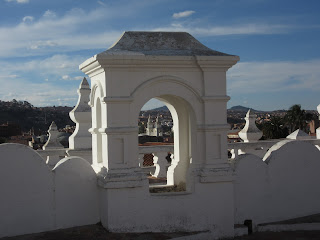After taking a welcome respite at our guesthouse in Sucre from our morning wanderings, we hailed a taxi for only $1.30 to Museo de la Recoleta located on a huge square overlooking the city.
La Recoleta was established by the Franciscans in 1601 as a place of rest for the monks. It has served not only as a monastery and museum, but also a prison and barracks. It was abandoned in 1826 until years later when the Franciscans returned to the city.
Throughout its history, the monastery collected together important paintings and sacred objects. One of the most unique items in Sucre was the monastery's 17th century cedar choir that had originally been in the San Franciscan church in the center. There was only a Spanish-speaking guide of the monastery and grounds but we, I like to think, understood a good portion of what she said as she spoke very slowly!
Beside the tiled painting was part of a poem dedicated to Juana Azarduy, a South American guerrilla leader who fought for independence from Spanish rule in the early 19th century.
The first courtyard:
Our guide mentioned there were only nine friars living there now. This was what their rooms looked like in the 19th century.
Entrance to the second courtyard:
There were multiple gardens, but they appeared run down and unkempt looking, though the guide took great pride in pointing them out. These were orange and grapefruit trees.
The guide expressed great pride in the patio's 1,500 year-old cedar (or was it a cypress tree as others claimed?) as it was the oldest tree in the country! Eight people could link arms and surround the tree or only seven if they were bigger, she said! I only learned later we could have walked around it three times and made a wish.
The bodega - in this case, a small wine cellar and not a small grocery store in a Spanish-speaking neighborhood seen all over the US - was used from the monastery's first days until 1983. Two presses were used or the grapes were stomped on in the cellar's vat.
The guide explained the paintings were done by anonymous artists from the 17th and 18th centuries. The priests' gold and silver vestments weighed from five to seven pounds each!
The guide kindly 'turned a blind eye' so I could take these pictures from the room's entrance and where the security cameras couldn't spot me. However, I wasn't able to take a shot of the most realistic sculpture of Jesus from 1657 I had seen whose veins were clearly visible. I wish I could also have shown it to you.
This painting was from the era when the monastery was a military barracks for ten years.
I was glad the tour took us to see the museum's/monastery's highlight, the magnificent carved choir stalls dating from the 1870s. Each one was intricate and unique and represented martyrs who were crucified in Nagasaki, Japan, in 1595.
A view of the church from the choir loft was as much as we could see of it as it was only open for Mass in the morning and evening.
Bolivia's fifth president, 33-year old General Pedro Blanco, was assassinated at the monastery on the evening of December 31st, 1828.
Another view of the rather downtrodden garden:
Bordering the square was a large Franciscan school.
Across the square was a lovely covered arcade.
The view was equally attractive from the arcade back across the square with the monastery in the background.
Another beautiful view overlooking Sucre:
We figured we could manage walking down the steep hill into Sucre after being lazy louts and taking the taxi up to the Museo and square earlier!
These interesting and attractive buildings on the stroll into town caught my eye.
Since arriving in Sucre a couple of days earlier, one of our 'goals' had been to view, from the inside, the Convento de San Felipe Neri. We had passed it by at least five times already but that afternoon was the first time we found it open. Hooray!
The very inconspicuous entrance:
An interesting painting of the Last Supper hung just inside the entrance. Click on the picture to make it bigger and you will see Judas, standing apart from the others and painted to look like a red devil.
As I wrote in a previous post, the church was originally constructed of stone but was later covered with a layer of stucco. The building used to serve as a monastery but it had since been converted into a parochial school.
Since classes were out for the day, we were able to wander around to our hearts' content.
I went to a parochial school, Our Lady of Mount Carmel in Ottawa, Canada, but it sure wasn't a patch on this exquisite building!
The stairwells were lined with paintings that prepared the monks from an earlier age for confession.
I was amused to find out this room was now used for band practice!
Seeing Hebrew letters atop one of the paintings on the altar in the former monastery was rather strange, wouldn't you agree?
An open confessional:
We had just seen students using the benches and chairs for study sessions or were they gab sessions possibly?!
I read that asceticism didn't prevent monks from appreciating the exquisite views from the rooftop while meditating!
The cobblestone roof was quite slanted in spots which made for an interesting walk on it!
You can certainly see why Sucre was also called the White City.
When I saw these pictures again I took four months ago today, it brought back fabulous memories of why we had such a fantastic time visiting Sucre. Even though we had only been there for a short time, I could begin to understand why so many foreigners have chosen to relocate to Bolivia's constitutional capital.
Next post: Spain's former silver mining boom town, Potosi.
Posted on March 13th, 2018, from Littleton, Colorado.
































































No comments:
Post a Comment